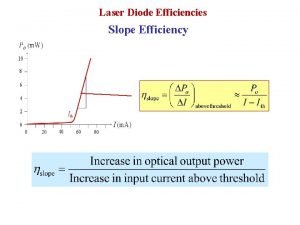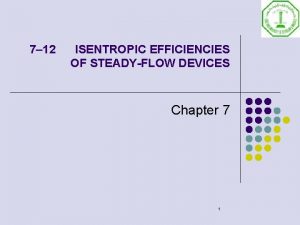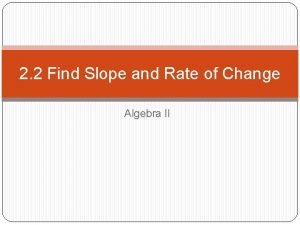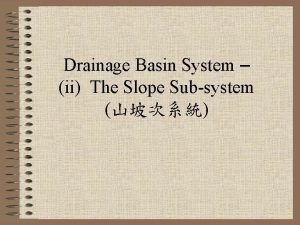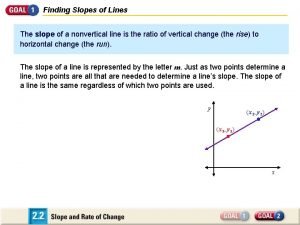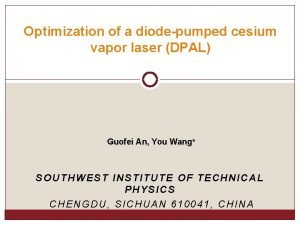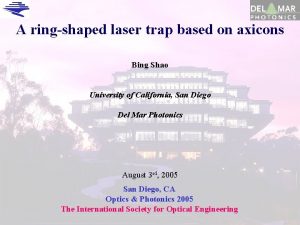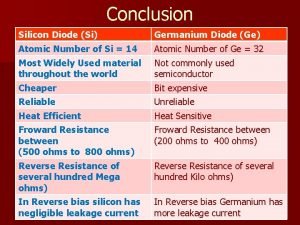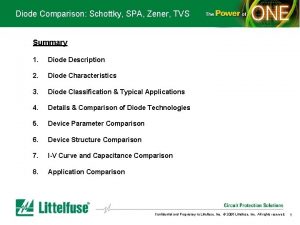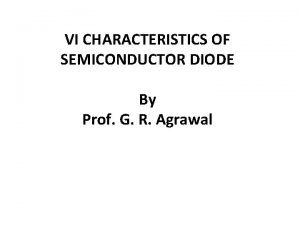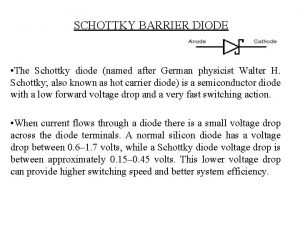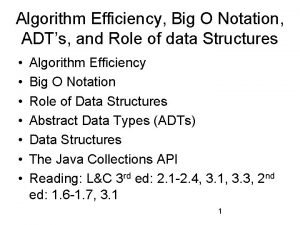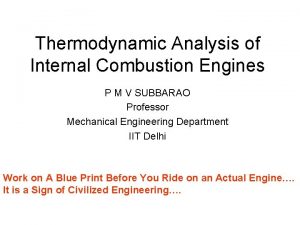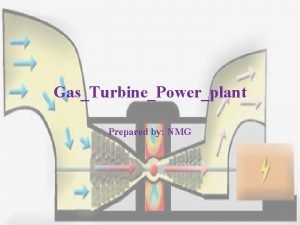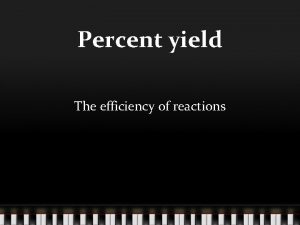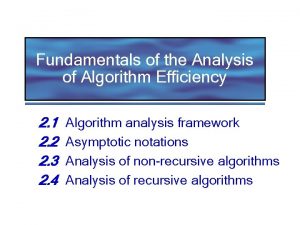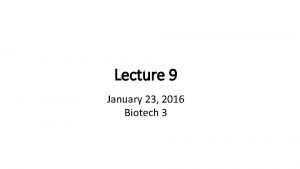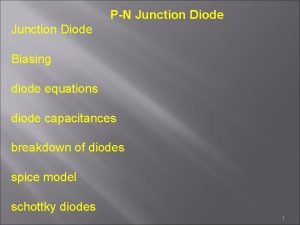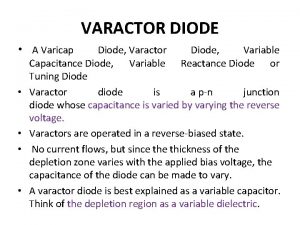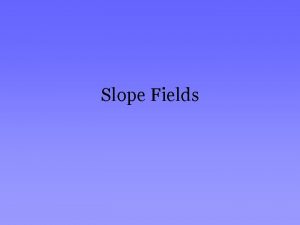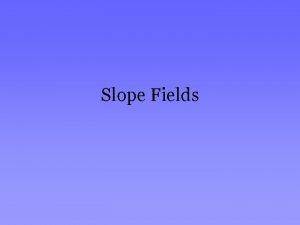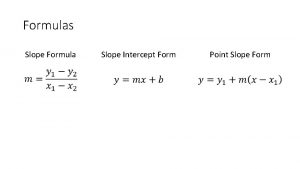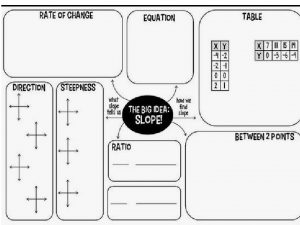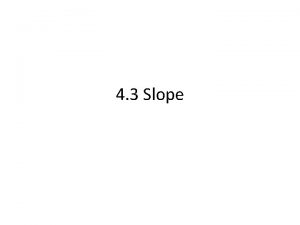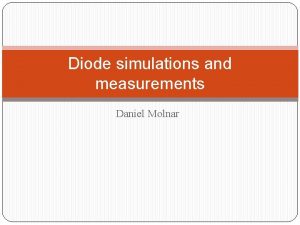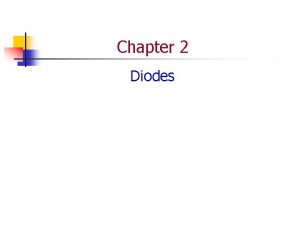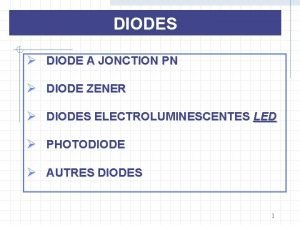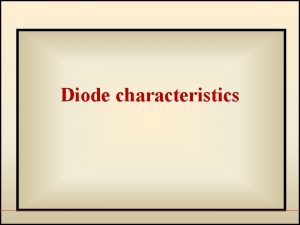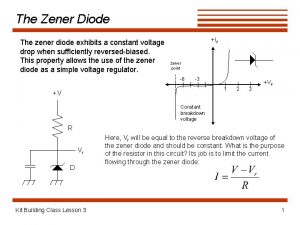Laser Diode Efficiencies Slope Efficiency Laser Diode Efficiencies


































- Slides: 34

Laser Diode Efficiencies Slope Efficiency

Laser Diode Efficiencies External Quantum Efficiency

Laser Diode Efficiencies External Differential Quantum Efficiency

Laser Diode Efficiencies Internal Quantum Efficiency tnr = Nonradiative recombination time tr = Radiative recombination time

Laser Diode Efficiencies Internal Differential Quantum Efficiency If the current increases by DI above threshold, increase in the injected electrons is DI/e The increase in the number of photons generated internally is then h. IDQE × DI/e

Laser Diode Efficiencies Extraction efficiency = (Loss from the exit cavity end) / (Total loss) h. EE = (1/2 L)ln(1/R 1) / at

Laser Diode Efficiencies Po = h. EEh. IDQEhu(I - Ith)/e hslope = DPo/ DI = h. EEh. IDQEhu/e h. EDQE = (DPo/ hu) / (DI/e) = (Po/ hu) / [(I - Ith)/e] = h. EEh. IDQE

Laser Diode Efficiencies Power Conversion Efficiency

Laser Diode Efficiencies Typical characteristics for a few selected red and violet commercial laser diodes. All LDs are MQW structures and have FP cavities. Violet lasers are based on In. Ga. N/Ga. N MQW, and red LEDs use mainly Al. Ga. In. P/Ga. In. P MQW. LD Red Red Violet Po (m. W) 500 100 50 10 400 120 10 l Ith I V (nm) 670 660 639 405 405 (m. A) 400 75 60 30 160 45 26 (m. A) 700 180 115 40 390 120 35 (V) 2. 4 2. 5 2. 3 5. 0 4. 8 q 21 18 17 21 45 17 19 q// hslope h. PCE 10 9 10 8 15 8 8. 5 (m. W/m. A) 1. 0 0. 90 1. 7 1. 6 1. 1 % 30 22 19 11 21 20 6. 0

Laser Diode Efficiencies Typical values for the threshold current Ith, slope efficiency (hslope ) and power conversion efficiency (h. PCE) for 36 commercial red LDs with different optical output powers from 3 m. W - 500 m. W.

EXAMPLE: Laser diode efficiencies for a sky blue LD Consider a 60 m. W blue LD (Nichia Sky. Blue NDS 4113), emitting at a peak wavelength of 488 nm. The threshold current is 30 m. A. At a forward current of 100 m. A and a voltage of 5. 6 V, the output power is 60 m. W. Find the slope efficiency, PCE, EQE and EDQE. Solution From the definition in Eq. (4. 12. 2), hslope = Po / (I - Ith) = (60 m. W) / (100 - 30 m. A) = 0. 86 m. W/m. A-1 From Eq. (4. 12. 8), PCE is h. PCE = Po / IV = (60 m. W) / [(100 m. A)(5. 6 V)] = 0. 11 or 11% We can find the EQE from Eq. (4. 12. 3) but we need hu, which is hc/l. In e. V, hu (e. V) = 1. 24 / l (mm) = 1. 24 /0. 488 = 2. 54 e. V EQE is given by Eq. (4. 12. 3) h. EQE = (Po /hu) / (I /e ) = [(60× 10 -3)/(2. 54× 1. 6× 10 -19)]/[(100× 10 -3) /(1. 6× 10 -19)] 0. 24 or 24% =

EXAMPLE: Laser diode efficiencies for a sky blue LD Solution (continued) Similarly, h. EDQE is given by Eq. (4. 12. 4 b) above threshold, h. EDQE = (DPo /hu) / (DI /e ) (Po /hu) / [( I - Ith )/e )] = [(60× 10 -3)/(2. 54× 1. 6× 10 -19)] / [(100× 10 -3 -30× 10 -3)/1. 6× 10 -19)] = 0. 34 or 34% The EDQE is higher than the EQE because most injected electrons above Ith are used in stimulated recombinations. EQE gauges the total conversion efficiency from all the injected electrons brought by the current to coherent output photons. But, a portion of the current is used in pumping the gain medium.

EXAMPLE: Laser diode efficiencies Consider an In. Ga. As FP semiconductor laser diode that emits CW radiation at 1310 nm. The cavity length (L) is 200 mm. The internal loss coefficient as = 20 cm-1, R 1 = R 3 0. 33 (cleaved ends). Assume that internal differential quantum efficiency, IDQE, is close to 1. The threshold current is 5 m. A. What is the output power Po at I = 20 m. A? The forward voltage is about 1. 3 V. What is the EDQE and conversion efficiency? Solution From the definition of IDQE in Eq. (4. 12. 6), the number of internal coherent photons generated per second above threshold is h. IDQE(I - Ith)/e. Thus, Internal optical power generated = hu ×h. IDQE(I - Ith)/e The extraction efficiency h. EE then couples a portion of this optical power into the output radiation. The output power Po is then h. EE × hu ×h. IDQE(I - Ith)/e. Thus, Po = h. EEh. IDQEhu(I - Ith)/e The slope efficiency from Eq. (4. 12. 2) is hslope = DPo / DI = h. EEh. IDQE(hu/e ) Output power vs current Slope efficiency (4. 12. 9) (4. 12. 10)

EXAMPLE. 3: Laser diode efficiencies Solution (continued) Further, from the definition of EDQE and Eq. (4. 12. 9) is h. EDQE = (DPo / hu) / (DI /e) = (Po / hu) / [(I - Ith)/e] = h. EEh. IDQE External differential quantum efficiency (4. 12. 11) We can now calculate the quantities needed. The total loss coefficient is at = as + (1/2 L) ln (1 / R 1 R 2) =2000 + (2× 200× 10 -6)-1 ln(0. 33× 0. 33)-1 = 7543 m-1 The extraction efficiency is h. EE = (1/2 L)ln (1/R 1) / at = (2× 200× 10 -6)-1 ln(1/0. 33) / (7543) = 0. 37 or 37%

EXAMPLE: Laser diode efficiencies Solution (continued) Thus, using I = 20 m. A in Eq. (4. 12. 9), Po = (0. 37)(1)[(6. 62× 10 -34)(3× 108)/(1310× 10 -9)][(0. 02 - 0. 005) / (1. 6× 10 -19)] = 5. 2 m. W The slope efficiency from Eq. (4. 12. 10) is hslope = DPo / DI = (5. 2 m. W - 0) / (20 m. A - 5 m. A) = 0. 35 m. W m. A-1 The EDQE from Eq. (4. 12. 11) is h. EDQE = h. EEh. IDQE = 0. 37 or 37% The power conversion efficiency h. PCE = Po / IV = 5. 2 m. W / (20 m. A × 1. 3 V) = 0. 20 or 20%

Laser Diode Equation A highly simplified and idealized description of a semiconductor laser diode for deriving the LD equation. (a) The heterostructure laser diode structure. (b) The current I injects electrons in the conduction band, and these electrons recombine radiatively with the holes in the active region. (c) The coherent radiation intensity across the device; only a fraction G is within the active region where there is optical gain. (d) Injected electron concentration n and coherent radiation output power Po vs. diode current I. The current represents the pump rate.

Laser Diode Equation Radiative lifetime Rate of electron injection by current I = Rate of spontaneous emissions + Rate of stimulated emissions Rate of coherent photon loss in the cavity = Rate of stimulated emissions Photon cavity lifetime

Laser Diode Equation Threshold Substitute back into steady state rate equation

Laser Diode Equation Light intensity = Po / A

Threshold Gain G= Fraction of the coherent optical radiation within the active region The gain g works on the radiation within the cavity, which means that we must multiply g with G to account for less than perfect optical confinement

Optical Gain Curve (a) (b) (a) The density of states and energy distribution of electrons and holes in the conduction and valence bands respectively at T > 0 in the SCL under forward bias such that EFn - EFp > Eg. Holes in the VB are empty states. (b) Gain vs. photon energy (hu).

Optical Gain Curve Optical gain g vs. photon energy for an In. Ga. As. P active layer (in a 1500 nm LD) as a function of injected carrier concentration n from 1× 1018 to 3× 1018 cm-3. (The model described in Leuthold et al, J. Appl. Phys. , 87, 618, 2000 was used to find the gain spectra at different carrier concentrations. ) (Data combined from J. Singh, Electronic and Optoelectronic Properties of Semiconductor Structures, Cambridge University Press, 203, p 390; N. K. Dutta, J. Appl. Phys. , 51, 6095, 1980; J. Leuthold et al, J. Appl. Phys. , 87, 618, 2000. )

Optical Gain Curve The dependence of the peak gain coefficient (maximum g) on the injected carrier concentration n for Ga. As (860 nm), In 0. 72 Ga 0. 28 As 0. 6 P 0. 4 (1300 nm), and In 0. 60 Ga 0. 40 As 0. 85 P 0. 15 (1500 nm) active layers. (Data combined from J. Singh, Electronic and Optoelectronic Properties of Semiconductor Structures, Cambridge University Press, 203, p 390; N. K. Dutta, J. Appl. Phys. , 51, 6095, 1980; J. Leuthold et al, J. Appl. Phys. , 87, 618, 2000. )

EXAMPLE: Threshold current and optical output power from a Fabry-Perot (FP) heterostructure laser diode Consider Ga. As DH laser diode that lases at 860 nm. It has an active layer (cavity) length L of 250 mm. The active layer thickness d is 0. 15 mm and the width W is 5 mm. The refractive index is 3. 6, and the attenuation coefficient as inside the cavity is 103 m-1. The required threshold gain gth corresponds to a threshold carrier concentration nth 2× 1018 cm-3. The radiative lifetime tr in the active region can be found (at least approximately) by using tr = 1/Bnth, where B is the direct recombination coefficient, and assuming strong injection as will be the case for laser diodes [see Eq. (3. 8. 7) in Chapter 3]. For Ga. As, B 2× 10 -16 m 3 s-1. What is the threshold current density and threshold current? Find the output optical power at I = 1. 5 Ith, and the external slope efficiency hslope. How would G = 0. 5 affect the calculations? Solution The reflectances at the each end are the same (we assume no other thin film coating on the ends of the cavity) so that R = (n-1)2/ (n+1)2 = 0. 32. The total attenuation coefficient at and hence threshold gain gth, assuming G = 1 in Eq. (4. 13. 9), is = 55. 6 cm-1 From Figure 4. 48(b), at this gain of 56 cm-1, nth 2× 1018 cm-3. This is the threshold carrier concentration that gives the right gain under ideal optical confinement, with G = 1.

EXAMPLE: Threshold current and optical output power from a Fabry-Perot (FP) heterostructure laser diode Solution (continued) The radiative lifetime tr = 1/Bnth = 1/[2× 10 -16 m 3 s-1)( (2× 1024 m-3)] = 2. 5 ns Since J = I/WL, the threshold current density from Eq. (4. 13. 4) is = = 1. 9× 107 A m-2 or 1. 9 k. A cm-2 or 19 A mm-2. The threshold current itself is, Ith = (WL)Jth = (5× 10 -6 m) (250× 10 -6 m)(1. 9× 107 A m-2) 0. 024 A or 24 m. A The photon cavity lifetime depends on at, and is given by tph = n/(cat) = 3. 6 / [(3× 108 m s-1)(5. 56× 103 m-1)] = 2. 16 ps The laser diode output power is =

EXAMPLE: Threshold current and optical output power from a Fabry-Perot (FP) heterostructure laser diode Solution (continued) That is Po = (0. 35 W A-1)(I – Ith ) = (0. 35 m. W m. A-1)(I – 24 m. A) When I = 1. 5 Ith = 36 m. A, Po = (0. 35 m. W m. A-1)(36 m. A-24 m. A) = 4. 2 m. W The slope efficiency is the slope of the Po vs. I characteristic above Ith, = 0. 35 m. W m. A-1 We can now repeat the problem say for G = 0. 5, which would give Ggth = at, so that gth = 55. 6 cm-1 / 0. 5 = 111 cm-1. From Figure 4. 48 (b), at this gain of 111 cm-1, nth 2. 5× 1018 cm-3. The new radiative lifetime, tr = 1/Bnth = 1/[2. 0× 10 -16 m 3 s-1)(2. 5× 1024 m-3)] = 2. 0 ns The corresponding threshold current density is Jth = nthed/tr = (2. 5× 1024 m-3)(1. 6× 10 -19 C)(0. 15× 10 -6 m)/(2. 0× 10 -9 s) = 30 A mm-2 and the corresponding threshold current Ith is 37. 5 m. A

EXAMPLE: Threshold current and optical output power from a Fabry-Perot (FP) heterostructure laser diode Solution (continued) There are several important notes to this problem • First, the threshold concentration nth 2× 1018 cm-3 was obtained graphically from Figure 4. 48 (b) by using the gth value we need. • Second is that, at best, the calculations represent rough values since we also need to know how the mode spreads into the cladding where there is no gain but absorption and, in addition, what fraction of the current is lost to nonradiative recombination processes. We can increase as to account for absorption in the cladding, which would result in a higher gth, larger nth and greater Ith. If tnr is the nonradiative lifetime, we can replace tr by an effective recombination time t such that , which means that the threshold current will again be larger. We would also need to reduce the optical output power since some of the injected electrons are now used in nonradiative transitions. • Third, is the low slope efficiency compared with commercial LDs. hslope depends on tph, the photon cavity lifetime, which can be greatly improved by using better reflectors at the cavity ends, e. g. , by using thin film coating on the crystal facets to increase R.

Distributed Bragg Reflector (DBR) LDs (a) The basic principle of the Distributed Bragg Reflection (DBR) laser. (b) Partially reflected waves at the corrugations can only constitute a reflected wave when the wavelength satisfies the Bragg condition. Reflected waves A and B interfere constructively when q(l. B/n) = 2 L. (c) Typical output spectrum. SMSR is the side mode suppression ratio.

Distributed Feedback (DFB) LDs LEFT: Distributed feedback (DFB) laser structure. The mode field diameter is normally larger than the active layer thickness and the radiation spreads into the guiding layer. RIGHT: There are left and right propagating waves, partial reflections from the corrugation, and optical amplification within the cavity, which has both the active layer and the guiding layer.

Distributed Feedback (DFB) LDs LEFT: Ideal lasing emission output has two primary peaks above and below l. B. RIGHT: Typical output spectrum from a DFB laser has a single narrow peak with a dl typically very narrow, and much less than 0. 1 nm

Distributed Bragg Reflector (DBR) and Distributed Feedback (DFB) LDs Selected properties of DBR, DFB and external cavity (EC) laser diodes Note: fm is 10 -15 s; du and dl are spectral widths (FWHM). SMSR is the side mode suppression ratio, TEC is a thermoelectric cooler LD l 0 du, dl SMSR Po I hslope (nm) � d. B m. W m. A 2 MHz, 8 fm 10 MHz, 0. 08 pm 45 80 200 0. 8 45 80 190 0. 2 45 40 300 0. 3 Comment DBRa 1063 DFBb 1063 DFBc 1550 DFBd 1653 0. 1 nm 35 5 30 0. 23 ECe 1550 50 k. Hz; 0. 4 fm 45 40 300 0. 2 Ga. As DBR LD for spectroscopy and metrology, includes monitor current, TEC and thermistor. Ga. As DFB LD for spectroscopy and metrology, includes monitor current, TEC and thermistor Pigtailed to a fiber, includes monitor current, TEC and thermistor. CW output for external modulation. For use in long haul DWDM. Pigtailed to a single mode fiber, includes monitor current, TEC and thermistor. Mainly for fiber optic sensing. Pigtailed. Tunable over Du = 3 GHz. Mainly for communications a. Eagleyard, EYP-DBR-1080 -00080 -2000 -TOC 03 -0000; b. Eagleyard, EYP-DFB-1083 -00080 -1500 -TOC 03 -0000; c. Furukawa-Fitel, FOL 15 DCWD; d. Inphenix, IPDFD 1602; e. Covega SFL 1550 S, marketed by Thorlabs.

Example: DFB LD wavelength Consider a DFB laser that has a corrugation period L of 0. 22 mm and a grating length of 400 mm. Suppose that the effective refractive index of the medium is 3. 5. Assuming a first order grating, calculate the Bragg wavelength, the mode wavelengths and their separation. Solution The Bragg wavelength is = 1. 5400 mm. and the symmetric mode wavelengths about l. B are so that the m = 0 mode wavelengths are l 0 = 1. 53915 or 1. 54085 mm. The two are separated by 0. 0017 mm, or 1. 7 nm. Due to a design asymmetry, only one mode will appear in the output and for most practical purposes the mode wavelength can be taken as l. B. Note: The wavelength calculation was kept to five decimal places because lm is very close to l. B. .

External Cavity Laser Diodes (ECLD) A simplified diagram of an external cavity diode laser (ECDL), which uses an angled interference filter (IF) to select the wavelength lo (depends on the angle of the IF), and the optical cavity has a GRIN lens with one end coated for full reflection back to the LD. The output is taken from the left facet of the LD.

External Cavity Laser Diodes (ECLD) LEFT: A commercial external cavity diode laser, based on the principle shown on the right. (US Patent 6, 556, 599, Bookham Technology). The output is a single mode at 785 nm ( 1. 5 pm) with a linewidth less than 200 k. Hz, and coupled into a fiber. The output power is 35 m. W, and the SMSR is 50 d. B. (ECDL, SWL -7513 -P. Courtesy of Newport, USA)
 Laser diode slope efficiency
Laser diode slope efficiency Ecological efficiency
Ecological efficiency Isentropic efficiencies of steady flow devices
Isentropic efficiencies of steady flow devices Financial efficiencies with captive
Financial efficiencies with captive Allocative efficiency vs productive efficiency
Allocative efficiency vs productive efficiency Productively efficient vs allocatively efficient
Productively efficient vs allocatively efficient Productively efficient vs allocatively efficient
Productively efficient vs allocatively efficient Slope review classifying slope
Slope review classifying slope The difference between slope decline and slope retreat
The difference between slope decline and slope retreat Converting point slope to slope intercept
Converting point slope to slope intercept Slopes of lines
Slopes of lines Laser diode working principle
Laser diode working principle Dpal laser
Dpal laser Axicon
Axicon Germanium and silicon diode
Germanium and silicon diode Schottky vs zener
Schottky vs zener How is zener diode different from pn junction diode
How is zener diode different from pn junction diode Why schottky diode is called hot carrier diode
Why schottky diode is called hot carrier diode Srs8
Srs8 Consumers producers and the efficiency of markets
Consumers producers and the efficiency of markets Energy efficiency revolving fund
Energy efficiency revolving fund Algorithm efficiency
Algorithm efficiency Efficiency of otto cycle
Efficiency of otto cycle Algorithm efficiency is typically a concern for
Algorithm efficiency is typically a concern for Gas turbine working principle
Gas turbine working principle What is capital market efficiency
What is capital market efficiency ønet
ønet Efficiency equation
Efficiency equation Marketing efficiency ppt
Marketing efficiency ppt Mathematical analysis of non-recursive algorithms
Mathematical analysis of non-recursive algorithms How to calculate transformation efficiency
How to calculate transformation efficiency Work is done when *
Work is done when * 175/5
175/5 Georgia energy efficiency standards
Georgia energy efficiency standards Efficiency and effectiveness in higher education
Efficiency and effectiveness in higher education
